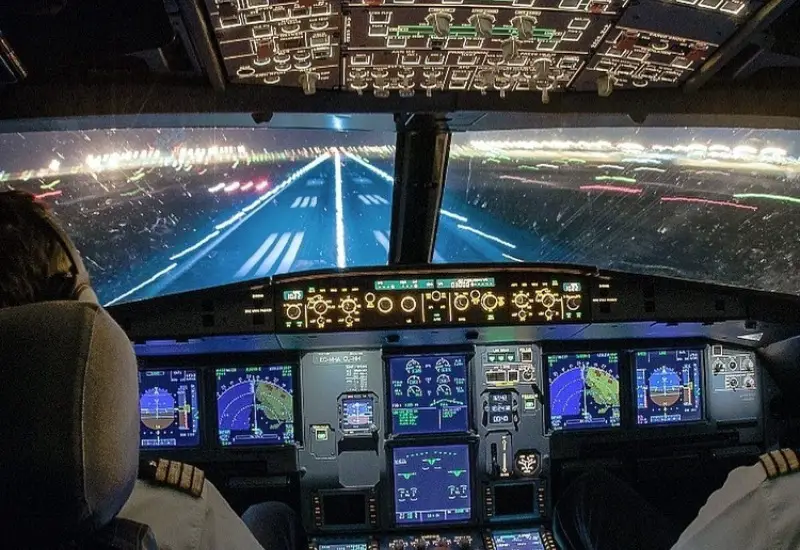A pilot’s license is the entry ticket to an exciting and rewarding career, of that there’s no doubt. It takes dedication, hard work and maybe a few knockbacks on the journey, but it’s well worth the effort.
So how do you go about getting this glittering prize?
What are the steps you need to take and the things that you should know? This is a guide that will help answer those questions.
Table of Contents
There are a few ways to become a commercial airline pilot, let’s take a look.
Flight Academies
If you choose a flight academy, you’ll spend an average of one year full time or two years part-time to complete all training.
These are the steps to follow:
1) Get your PPL (Private Pilot License / Certificate)
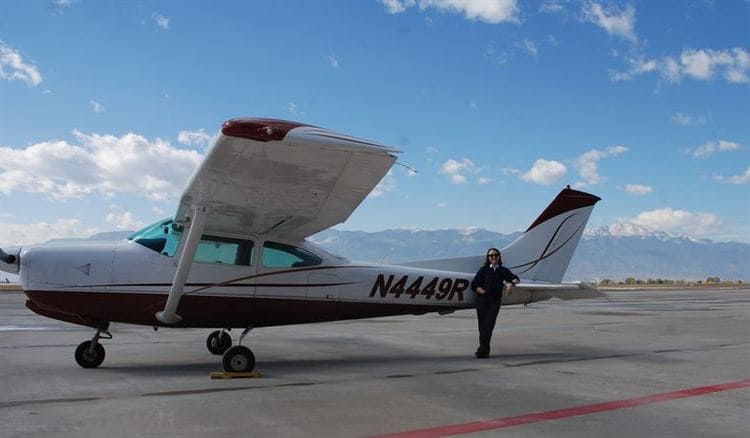
First, you need to get your PPL certificate, which will allow you to fly a single-engine plane for only recreational purposes (you can take friends or family, but you can’t receive any payment for the flight).
So how do I get my PPL (Private Pilot License)?
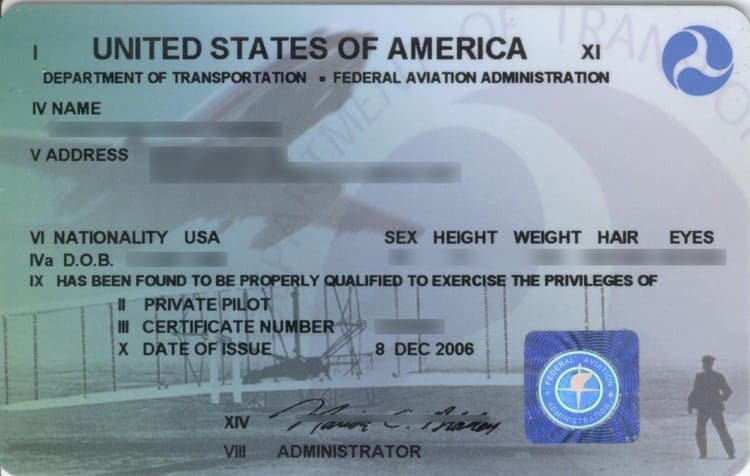
One of the most popular ways is by joining a flying academy that offers a course that will take you all the way from absolute beginner to the proud holder of a CPL.
What requirements do I need to meet to get into a Flying Academy?
- Most academies will want you to be at least 16 years old. A PPL can’t be issued to anyone under the age of 17.
- You have to – and this is important – be fluent in English. This means not only in the speaking of it, but the reading and writing of it. Communication is incredibly important in flying. You’ll hear this saying more than once in your training: Aviate, Navigate, Communicate.
- You will need a Pilot Medical Certificate Class 3. There are 3 Pilot Medical Certificates. The first one is for airline transport pilots, the second one for commercial pilots and the third one is for private pilots. They are all very similar, but class 3 is the least complex of the medical tests you will have to pass on your journey to a CPL(Commercial pilot license). But it’s easy to pass, so don’t worry.
Flight training methods
Firstly, let’s look at the two different types of flight training methods or schools:
Part 61 or part 141.
They both use the same syllabus and have the same training standards approved by FAA, and they both provide the same private pilot certificate.
So how do you choose which one is better?
Don’t worry, they are both good, you just need to pick which one is the best for your circumstances.
Part 141 school
This is basically the way flying academies are governed and regulated with regard to controlling how the student learns. If you choose this type of training, you’ll have a very structured curriculum and lesson plans scheduled in a flight school.
I’d personally recommend this pathway for those who already know that they want a professional career in aviation or want to progress faster. Because, although it can be a bit more intense, it means less flying time in order to qualify.
You will need to have 35 hours flight hours under part 141 as opposed to 40 for part 61.
You will also be able to achieve your CPL in only 190 flight hours against 250 hours in Part 61.
Part 61 school or instructor
This part is more flexible.
An approved FAA instructor will give you personalized training and will adapt to you.
You set up your schedules as you need.
The main advantage is flexibility, so it can be an option for part-time workers, students or people who are not planning to work professionally.
So, Part 141 or Part 61?
This is definitely your call, so speak to the flight academies you have chosen to use and let them guide you.
During your visit to the flight schools don’t forget to:
- Ask all the doubts you have. Prepare the visit in advance, read about the school, and jot down your questions before your visit
- Take notes, keep track of what you like or dislike
- Compare prices
- Compare their aircraft fleet, the simulators, the teachers, the school’s reputation and schedules, etc.
- Check if they have agreements with airlines to help you with job placement.
- Visit your favorite school last, so you’ll figure out the best questions to ask and you base your judgment on that.
My personal tip: Talk to students. If you want to know what’s good and bad about the school, this is no time to be shy. Prepare some questions beforehand. You’ll probably get some honest info which will be really helpful.
What do you mean by flight hours?
Okay, let’s break this down a little more, let’s take Part 141 and unpack it for you.
- 35 hours of minimum total time flying.
- 5 hours of solo flying minimum, including local and cross country. One cross country of more than 50 NM (nautical miles) and another of 100 NM. (Cross country is where you have been unleashed and you make an extended flight away from the airfield).
- One night cross country dual.
And Part 61?
- 40 hours minimum total flying time
- 10 hours of solo flying minimum
- The same distance and number of cross country’s.
So there is quite a difference, but as I said, both are valid and best decided with agreement and guidance from the staff at the academy you have chosen.
But how long will it take to get my PPL?
The flight hours for Part 141 and Part 61 are the minimum hours needed for qualification. Which is pretty straightforward, but for one very important factor.
Just because you have completed the required amount of flying time at any stage of your certification, that doesn’t mean that you will automatically pass.
Your flight instructors have the final say in whether or not you are ready for advancement during any stage of your training.
For example, you may well have done sufficient flight hours to qualify to go solo, but if your instructor doesn’t feel that you are ready, then it’s just not going to happen.
You will only be allowed in the cockpit by yourself when you are totally skilled and safe at flying the plane by yourself. No ifs, no buts and the same with maybes.
And the same will be the case before an examination flight for your PPL. Your instructor will take you up for a check flight before any exam, maybe even more than one, and if they don’t think that you are ready, then you will have to work hard at things until you are. It’s all about safety and your best interests.
How many hours will I have to do solo?
Under Part 141, your 35 flight hours will usually be broken down into 30 hours with your instructor and 5 hours flying solo. Under Part 61 its 10 hours.
But in the end, it will depend on your instructor.
Is there a practical exam for my PPL?
Yes.
The FAA will examine your abilities with a check flight that may last up to 1.5 hours.
Nerve-wracking for many, but your training will kick in and all will be good.
What is ground training?
Under Part 141, you’ll need to complete 35 hours minimum of what’s called ground training.
Which sounds like a lot, but when you think about it, that’s just one hour of classroom work for every hour up in the sky having fun flying.
Not a bad trade-off, really.
So what sort of classroom work will I have to do?
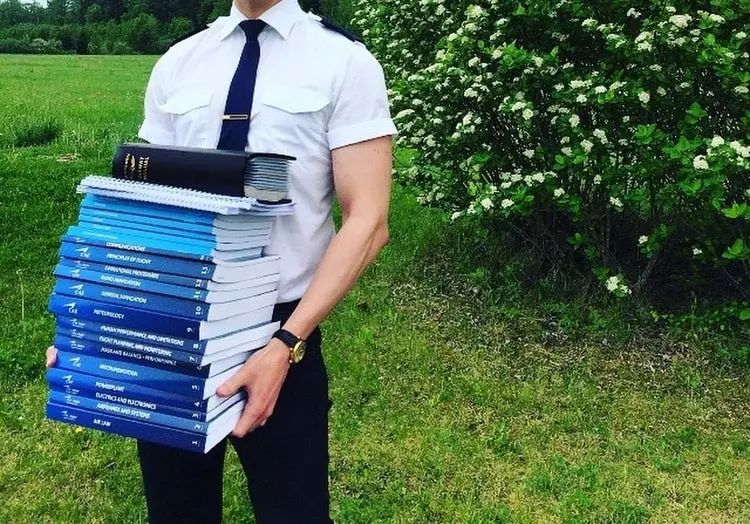
Let’s take a look at some of the topics that you will need to cover.
Bear in mind that you will be tested on these, but usually, they are broken up into modules and the work is easy to understand because it’s relevant to what you are doing in the airplane.
- Discovering Aviation
- Airplane Systems
- Aerodynamic Principles
- The Flight Environment
- Communications and Flight Information
- Stage I exam
The list above is to give a flavor of the type of lessons that make up the classroom work in training for your PPL.
And, yes, as you can see, you will be tested on what you are learning.
Which one is cheaper?
So, if you are going for part 61 it will depend on many factors:
- How many hours you’ll need: keep in mind that even though the minimum hours to get your PPL is 40 hours, most people take an average of 65 to 70 hours.
- Aircraft: Renting older and smaller airplanes is normally cheaper – from $90 to $130 per hour.
- Instructor cost: Depending on the instructor’s experience – $40 to $70 per hour.
- Ground school, materials, and headset – $500 to $900.
- Written test – $165 (pricing may vary by location).
- Flight test – $500 (pricing may vary by location).
- Plane rental for the check ride -$220 (2 hours).
- Medical certificate cost – $75 to $150.
*NOTE: This price estimate gives you an idea of the total cost, but it can be very different depending on the school, location, etc.
So because prices can vary a lot you’ll need to check many places, instructors, or call testing centers to find the one that suits you the best.
Part 61 training costs:
65 hours
| Aircraft | $105 x 65 | $6,825 |
| Instructor | $50 x 65 | $3,250 |
| Ground School+materials | $300 + $300 | $600 |
| Written test | $165 | $165 |
| Flight test | $500 | $500 |
| Plane rental | $110 x 2 | $220 |
| Medical certificate | $100 | $100 |
| TOTAL: | $11,660 |
TOTAL: $11,660
If you choose 141 training, make sure the course quote includes everything you need to complete the training.
Part 141 training costs:
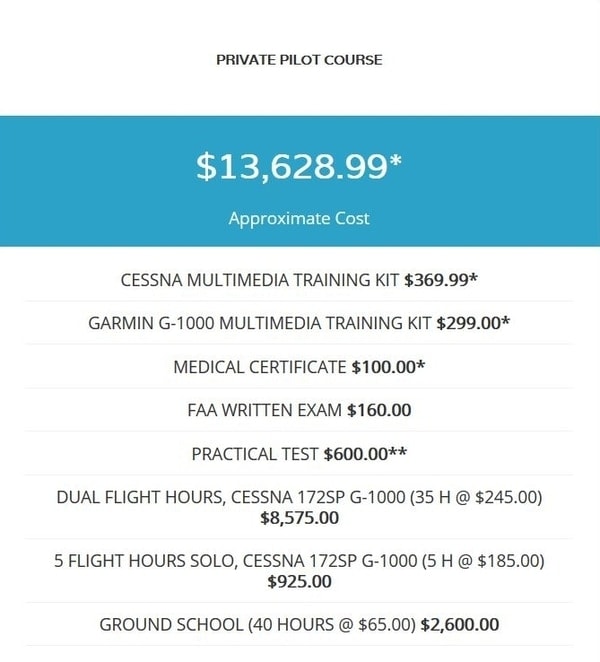
TOTAL: $13,628
2) Instrument Rating
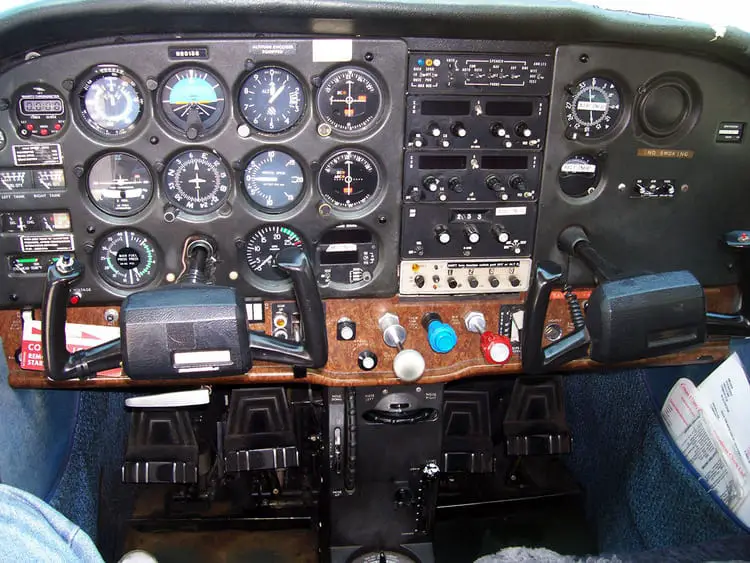
So, I’ve proudly achieved my PPL, what next?
Next, you’ll need to get your Instrument Rating (IR). This allows you to fly under IFR (Instrument Flight Rules).
When things are ok – good visibility, no turbulence, etc. – then you will fly under VFR, Visual Flight Rules. Which is pretty much what it says on the tin; you fly according to what you see.
But often us humans aren’t very well equipped to work out things from great heights and amongst clouds and weather, so we need instruments to augment our senses.
When you fly using your cockpit instruments, you’ll need to become proficient at reading and understanding what each and every one of them is telling you.
This is flying under Instrument Flight Rules and to do this you will need an IR.
How much does IR (Instrument rating) cost?
Here’s a Skyeagle Aviation Academy example.
| Based on Part 141 | Based on Part 61 | |
| Flight instruction | 25 hours $5,750 | $25 hours $5,750 |
| Simulator | 10 hours $1,600 | 20 hours $3,200 |
| Ground School | 30 hours $1,950 | 20 hours $1,300 |
| Written test | $185 | $185 |
| Checkride+plane rental | $900 | $900 |
| TOTAL | $10,385 | $11,335 |
How long does getting an IR take?
This is one of those ‘how long is a piece of string questions’.
Basically, you will get your IR when you have demonstrated that you are skilled enough to have earned it.
Which means a flying time, which means good weather and the right conditions.
Being in a flying academy will help because you will be flying regularly and often.
So, it can take as little as 30 days if you are flying every day.
But it will take a deal longer if conditions don’t allow for much flight time or if circumstances don’t permit it.
Your instructor will guide you in this, so be patient and understand that flying safely under IFR is everything.
Make no mistake, your instrument rating is extremely important.
3) Multi-Engine Rating
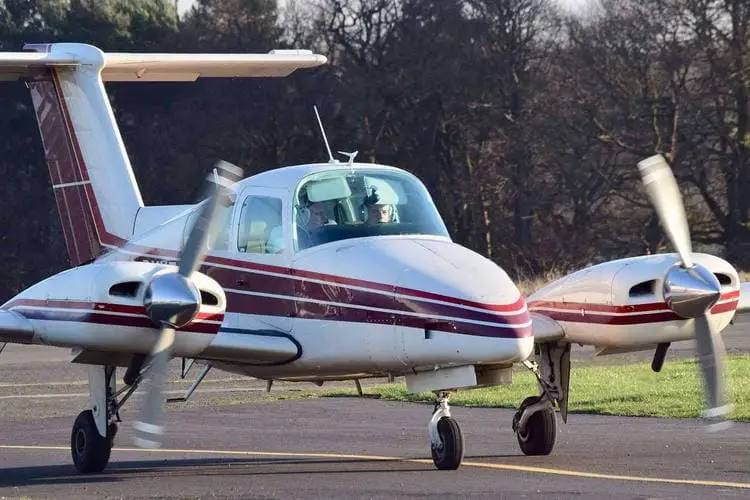
After IR comes the Multi-Engine Rating
Obviously, you’re eventually going to need to fly planes with more than one engine and this takes a whole new bunch of skills.
So you’ll need to be trained in multi-engine flying.
And here again, I can’t give you a definite time frame. But after sufficient training, you will have to undergo a check ride, where your ability to fly with one engine failed and your general competence at straight and level flying, instrument approaches, etc. will be assessed.
Ten hours or a few weeks seems to be a consensus as an approximation of the time you’ll need.
But again, you will be guided by your flight instructor.
How much is the Multi-Engine Rating?
Here’s what Aspenflyingclub.com tells us.
| Flight instruction | $269 x 10 hours | $2690 |
| Instructor | $75 x 15 hours | $1,125 |
| Books & Materials | $139 | $139 |
| Aircraft rental for checkride | $269 x 1.5 hours | $403.50 |
| FAA examiner fee | $600 | $600 |
| TOTAL | $4,957.50 |
4) Get your Commercial Pilot License (CPL)
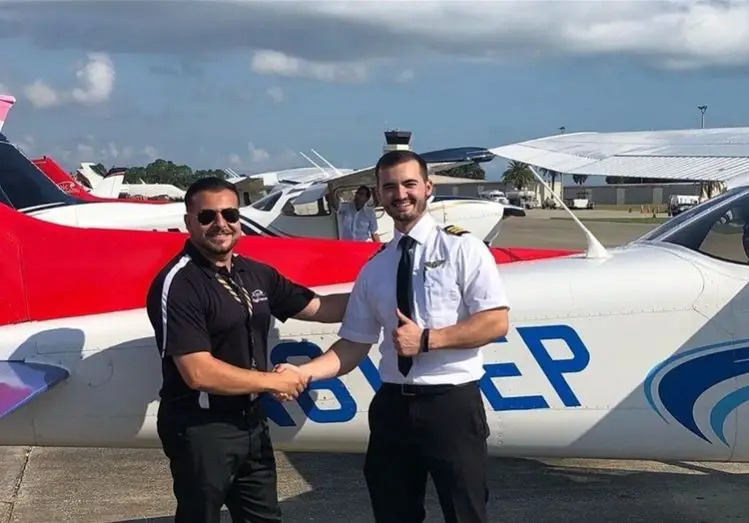
Now can I go for my CPL?
You’re the proud owner of a PPL, you’ve earned your IR and your Multi-Engine Rating, so are you good to go?
Nearly.
But be aware that getting your CPL really is raising the bar and hard work is not an optional extra if you want to succeed.
You will need to log in a minimum of 250 hours of flight time (including 100 hours as pilot in command and 50 hours cross country).
After passing the check ride and the Class 2 medical test, you’ll become a licensed commercial pilot.
And then you will be allowed to work and get paid. You will be able to start working doing crop dusting jobs (spraying insecticides or fertilizers on crops), photography, aerial tours, skydiving tours, etc. Most airline pilots begin their careers as commercial pilots.
5) Get Your ATP (Airline Transport Pilot)
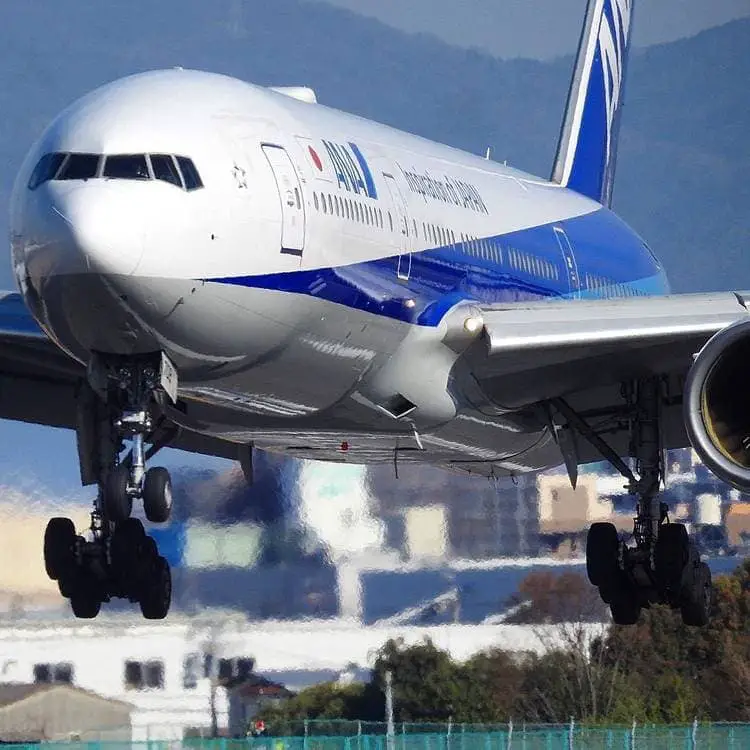
Can I become a commercial airline pilot after getting my Commercial Pilot License?
Not yet.
If you really want to get a commercial airline pilot job, you’ll need to earn your ATP Certificate first.
And the ATP requires you to build up your flying hours first.
In the United States, you need at least 1500 flying hours to be eligible to work for a commercial airline.
Additionally, the FAA requires a “Type Rating” (a certification to fly a certain aircraft type) to be able to pilot any large aircraft.
You will need to log in 1,500 hours of total flight time, including 500 hours of cross-country flight time, 100 hours of night time (or 75 hours with a minimum of 45 night landings) and 75 hours of instrument time (25 of which can be in a simulator), 250 hours PIC (Pilot in Command), 50 hours of Multi-engine.
And you will have to complete an Airline Transport Pilot Certification Training Program (ATP-CTP) before taking the written exam: 30 hours of ground training and 10 hours of simulator training.
Many airlines have created programs to include ATP-CTP training as part of their cadet pilot program. So this time instead of paying for flying, you can build up your hours and get paid for flying.
Another common way to build up hours is to become a flight instructor or to work as a pilot for private aviation or cargo companies.
Remember: To qualify for the ATP (Airline transport Pilot) Certificate you must be at least 23 and have a commercial pilot certificate and first-class medical certificate.
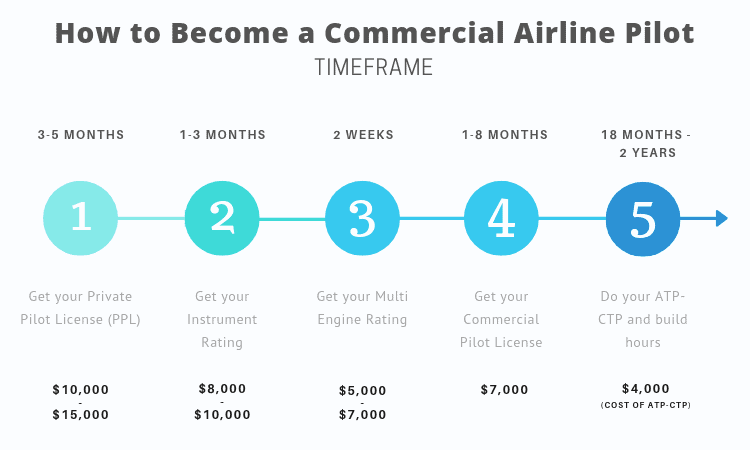
University or College Degree

Many universities offer degrees in aircraft operations, aviation, aeronautical engineering, or a related field. And some of them incorporate the achieving your PPL or CPL.
Keep in mind that the flight component is part of a wider degree and so involves all the studying and work that you would expect of any other university course.
Also, a University degree will have far higher educational entry requirements.
Let’s take a look at what, for example, Ohio State University has to offer:
The OHS College of Engineering offers a Bachelor of Science degree in aviation. To quote their information about the degree:
“The degree consists of engineering foundation coursework, aviation core courses, and technical electives. Mathematics, physics, chemistry, and various engineering disciplines make up the engineering foundation.“
So you have core coursework on engineering running alongside core aviation courses.
A lot of work.
One of the advantages of getting your CPL as part of a degree course is that the university, like Arizona State, for instance, may have a pathway or bridge program that is linked directly to airlines that are happy to take on new graduates.
A university course will cost more and take longer than an Academy course
That is perhaps stating the obvious, but you do need to be aware of considerations like time and cost.
Those are 2 big disadvantages, attending a University with an aviation program will take you 4 years and is normally over $135000
What do you want to do in the world of aviation?
If you are not sure about what you like, you can be also qualified for a variety of flight-related careers: Aerospace engineer, Aviation business management, Aircrafts Maintenance, technician, director of operations, etc. and other aviation careers possible.
So you may have a plan B in case things don’t turn out the way you wanted.
Do your research
There are so many permutations that universities offer in terms of degree courses, that you really do need to thoroughly research what is the best one for you.
And some airlines like Delta and Jetblue have a program for aviation College students and they allow them to earn a position as a First Officer if they complete all the program requirements.
These are some of the Universities they are partnering with:
- Embry-Riddle Aeronautical University-Daytona
- Embry-Riddle Aeronautical University-Prescott
- University of North Dakota
- Jacksonville University
- Auburn University
- Bridgewater State University
Get sound career advice. Please.
If you are thinking of expanding your horizons by embarking on a degree course, I really think that some external career advice is a must.
As I’ve said, the world of aviation is so much more than just pilots.
The appropriate vocational or career adviser can help you to find the right answers to all sort of questions.
Military
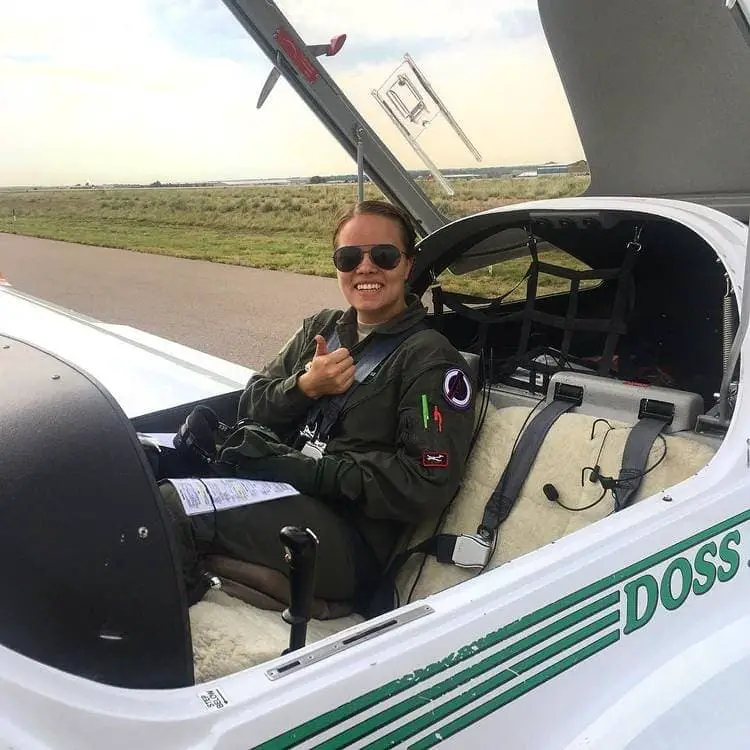
How does that work?
At the time of writing, there has been a shortage of both military and civilian pilots, although the USAF now says it has weathered the worst of this and has things back on track.
So what of life after the military? Do airlines prefer military-trained pilots?
Many do.
Among the things that military pilots have going for them is the rigorous flight training they have had, their ability to work as a team member and their leadership qualities.
These are all important and appealing attributes that the airlines are looking for.
In 2018, for instance, fifty percent of Delta Airlines pilots were ex-military.
But employment is not a given. All pilots are selected on an individual basis, so while a military background is a definite advantage, it’s not a meal ticket.
Also, a pilot can’t just leap from the cockpit of an F-35 fighter straight into that of a Boeing 737 and start work.
They are two entirely different beasts and transitional training is required.
But they only need 750 hours of flight training, instead of 1500 hours the civilians need.
That’s also why airlines are chasing military pilots.
My friend’s daughter in law, Lisa, is currently a pilot with Pioneer airlines after being in the USAF and obtaining the rank of Major. Her path to the Air Force was from a flight academy when she was sixteen and eventually into the Air Force as a cadet. Lisa became a B-1 bomber pilot, (the famous Bone) and served two tours of duty in Afghanistan.
When she left the Air Force, there was no structured path for her to become a civilian airline pilot, she had to line up and apply just like everyone else.
She did so, got a job with a small company running tourist flights over the Grand Canyon and then moved on to Pioneer airlines and now flies with them all over the US and loves it.
But Lisa still had to apply for and earn her ATP even after 20 years with the USAF.
She had her logbooks which proved her flying hours and she had all the relevant documents – medical certificates, discharge papers, etc, so that aspect of it was relatively easy.
But she still had to go through a check flight and be marked as rigorously as any other applicant.
From there, it was a matter of applying to airlines for work.
And, after acceptance, at least a couple of months work in simulators and cockpits to get type rated (a certification to fly a certain aircraft type).
Airline Cadet Programs for Pilots
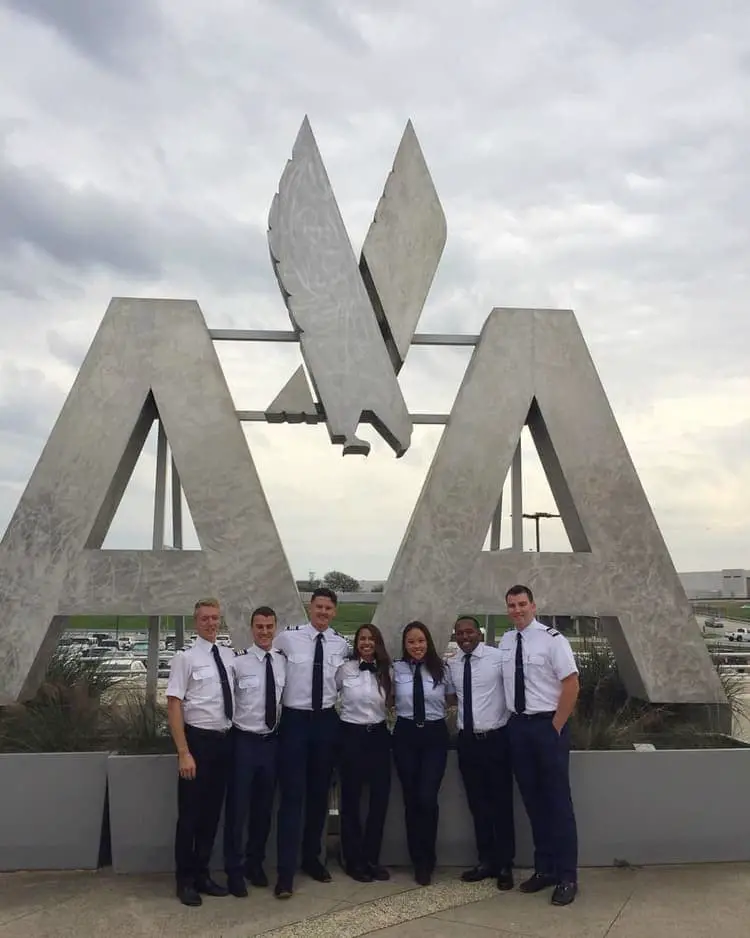
These are programs designed for those with little or no previous flight experience.
The major airlines do their own in-house training to selected applicants and guide them all the way to commercial airline pilot status.
Example #1: American Airlines Cadet Academy
Let’s take a look at American Airlines Cadet Academy and its pathway.
What qualifications do I need to apply?
You need to be legally allowed to work in the US, be 21 at the time the course finishes (it’s a 3 year course), have at least a high school diploma or GED (a college degree is preferred), have a first-class medical, hold a passport that allows you to travel in and out of the US, be proficient in reading, writing and speaking English and you must pass a background check.
Apply online
After filling out all the required fields on the application form, you will have to complete an assessment and essay.
Then, if you are selected to go further, you will have a video interview.
The application process is detailed and thorough: American Airlines is looking for the best applicants they can find.
If selected
You’ll join American Airlines Cadet Academy. And then the real work begins.
You will be taught everything that you need to learn about being a safe, competent and responsible pilot.
You will also be able to join their Discover Student Loan scheme which will go a long way in helping you to pay for your training.
This loan covers all tuition and material costs and there is an opportunity to defer payments if you are doing really well.
Interview offers follow
When you have successfully completed all your flight training, you will be eligible for an interview with one of American Airlines subsidiary regional companies.
And if you are selected you will be offered a job as a flight instructor or First Officer.
American Airlines expects the vast majority of participants to become employed due to the demand for pilots but they can’t guarantee a position before the interview.
Here are some other interesting cadet pilot programs.
In some of them, the interview is the first part of the selection, if you are selected they will help you find financial assistance and if you pass everything you will be guaranteed a position.
Example #2: Aer Lingus cadet pilot program
Aer Lingus cadet pilot program is only for those eligible to work and live in the EU.
Aer Lingus is seeking applicants for their Future Pilot training program.
This program is fully sponsored and it combines basic training lasting over 14 months in Jerez, Spain and A320 training in Dublin (4 months).
Competition will be fierce but it’s really a good program.
Of course, they will have a bond with the company after starting as First Officers, so if the pilots leave, they will have to pay the full amount of the training costs back.
Example #3: AirBaltic Training Pilot Academy
AirBaltic Training Pilot Academy offers a training program to develop your European aviation transport pilot license (“Frozen” EASA ATP) within approximately 18 months, with no previous aviation education or experience required.
For selected candidates, a pilot job will be guaranteed at AirBaltic immediately after selection.
Example #4: Envoy Air Cadet Program
Envoy Air is the largest regional carrier for American Airlines and their cadet program will allow you to earn money while you build flight hours.
You can become a paid flight instructor, you just need to have your Certified Flight Instructor Certificate with Instrument airplane ratings.
You will get $5000 in financial assistance, free travel benefits and earn $60000+ as a new First Officer.
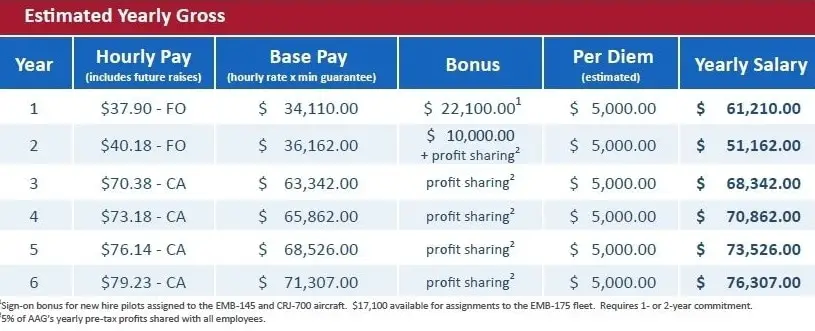
Example #5: United Airlines Pilot program
These are the steps to become a pilot for United Airlines according to their program.
- Earn an FAA commercial multi-engine pilot certificate and Instrument rating ($80,995 full financing available+Airline Tuition Reimbursement)
- Build experience as a Flight Instructor: 1500 hours as an instructor with ATP (graduates of this Program are guaranteed a certificated flight instructor job with ATP
- Earn tuition Reimbursement with ATP’s Airline partners (Commutair, United Express, Expressjet, Mesa Airlines)
- Start Flying as a Regional Airline Pilot (2 years): once you reach 1500 hours you will start flying for your regional airline, which allows you to schedule you United interview
- Start as a pilot with United Airlines: After 3000 hours experience as a regional pilot, you can transition directly to United Airlines with no additional interviews required.
Q&A
How much does it take to be a commercial airline pilot?
Approximately from $70000 to $130000, but as I said before, it depends on the path you choose and the school, the hours you need, etc.
If you find cheaper prices, make sure that they cover all costs.
Do they include the flight training taxes and the airport taxes?
Do they include all the materials and books?
Do they have good, experienced instructors?
How much does a commercial airline pilot earn?
This is a tricky question.
It depends a lot on your airline, your airline’s country, your position (first officer or captain) and how many hours you fly.
The spectrum is very wide, each airline has its own pay scales. And the salary will rise with the accumulation of seniority.
You’ll start in the company as:
- A trainee or a cadet pilot (they are normally issued 2 stripes on their uniform).
- First Officer: which is the second pilot or second in command or co-pilot (they usually have 3 stripes).
- Senior First Officer: you are still a co-pilot but after some time – 1 or 2 years or having logged 1000 hours – you are promoted to Senior First Officer.
- Captain: he is the Pilot in Command, responsible for everything that happens on the plane. After logging 1500 or 3000 hours you can be considered for promotion to captain.
It also depends on the type of operation and aircraft you fly. Regional Airlines with small planes normally pay lower wages. Long haul airlines will pay the highest salaries.
So airline pilots may get as little as $25,000 for their first year in a regional US airline rising to $65,000 after 12 years service in the same position as First Officer. And if they end up being promoted to captain, they can expect nearly $110,000 per year.
It’s a completely different situation when flying long haul; a first officer could immediately start earning $$90,000 up to $200,000.
So, even though the flight training to become a pilot can cost you over $100,000 it’s still worth it.
It’s a great investment in your future.
Is it hard to get a job as an commercial airline pilot?
Finding your first job as a pilot can be hard.
That’s why it’s so important to find a good school.
Some of them have agreements with airlines so that their students have direct access to job interviews.
Also, it’s necessary to stay in contact with your instructors or to make industry contacts who can help you get jobs.
Aviation is all about getting contacts in the industry.
You can also check online if there are any pilot recruitment open days, send your resume to all airlines, and to check and use internet pilot forums to get to know people and learn from their experiences.
For example:
But the good news is that now is a good time to become a commercial airline pilot, there is a real pilot shortage due to the increasing demand and airlines all over the world are finally hiring.
Are airline pilot studies hard? Do I need math and physics?
The studies are not especially hard but there is a lot to learn and you will have to work at it.
You only need basic maths and physics, not be an expert so don’t worry about that aspect. I know people who didn’t have a technical background at all and they succeeded at becoming airline pilots (some of my flight attendant colleagues for example).
So it all depends on you.
The thing is that you will have to learn and memorize a wide variety of subject such as:
Federal Aviation Regulations, Meteorology, Navigations, Communication, Aircraft performance, Flight principles, RTR (Radio Telephony Restricted), etc.
But if you really want it, go for it!
Don’t be daunted or put off by the requirements for any of the facets of your pilot training.
At first, it can all seem unobtainable, but take one careful thoughtful step at a time and you’ll reach your goal.
My tips
- My recommendation if you don’t want to end up graduating with significant loan debt and take this financial risk is to try to get into a good pilot cadet program of an airline or to look for scholarship programs to help you cover the fees for your pilot flight training. Here are some pilot training scholarship programs:
- Make sure you are sure about becoming a commercial airline pilot. This is one of the biggest steps that you will take in your life. Talk to family and friends and be very, very sure that this is the future for you.
- Also, make sure you meet the requirements for a class 1 medical certificate before spending your money on the training.
- Map out your career path on paper. Lay out each stage that you will need to do and have two columns beside it: the hours needed and the cost of doing it. Remember that there is more than one path to becoming a commercial airline pilot, so plan the one that suits both your needs and your finances.
- Visit aviation training exhibitions, those are events dedicated to pilot recruitment and training. You’ll meet the leaders in the industry, discover the training process and find out everything about aviation schools.
- Pilot Expo (Berlin): Europe’s largest event dedicated to flight crew recruitment and training
- Wats 2020 Orlando: World aviation training conference and trade show in Orlando
- Pilot careers Live (London, Dublin, Frankfurt): Meet the leading pilot training academies from the US, Europe and beyond, Universities, airlines, and other students.
- Start your training with patience and calmness. You will make mistakes and you will get frustrated; that touch and go that was more of a bump than a touch, that exam question that you didn’t expect, all of this is part of learning to be a pilot.
- Accept that your instructor is employed because of their experience and that they know an awful lot more than you do. Listen to them, take in what they say and do as they tell you.
- Remember that the aviation industry is a lot about who you know and what contacts you have. Make friends while you are training, these people are going to be part of the pilot brotherhood.
I know what you are thinking: considering the cost and the long and hard work involved, getting your pilot’s license doesn’t seem to be worth it.
But it totally is.
If you want to stick with just having your PPL, then you have access to one of the most satisfying hobbies on the planet.
If you want to go further and make a career out of flying, then the world almost literally is your enjoyment.
Either choice, I believe, is well worth the expense and effort. Living the life of a pilot is great!
Becoming a commercial airline pilot is one of the most important decisions you will make in your life and if it’s really your dream, you should not give up.
Study hard and I wish you all the best. Good luck!
